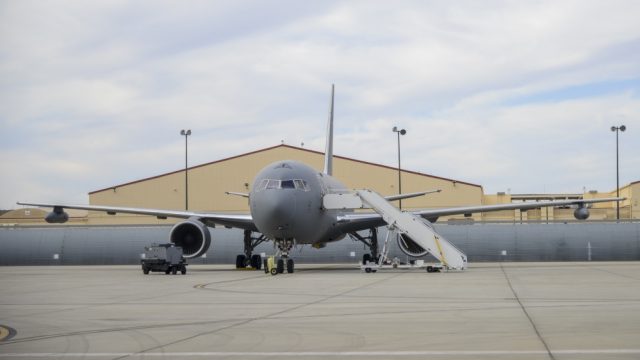
A month after starting Initial Operational Test and Evaluation (IOT&E), the US Air Force’s KC-46 Pegasus put its wing aerial refueling pods to the test at Edwards Air Force Base, California.
The test, carried out with an AV-8B, F-18D, and F-18G, was deemed a success by the service.
The WARPs allow the Pegasus to simultaneously refuel two aircraft at the same time which makes it a force multiplier.
“With WARPs, the KC-46 will be able to refuel two fighter aircraft at the same time; as opposed to a centerline drogue system, where only one aircraft can refuel at a time,” said Maj. Jacob Lambach, KC-46 Experimental Test Pilot, 418th Flight Test Squadron. “Fighter pilots usually show up in pairs and each has to watch and wait while their wingman refuels. Fighters’ combat mission isn’t to sit behind the tanker; it’s to fight. If we can refuel them both at the same time, they each only spend half as much time ‘out of the fight.”
Following successful completion of the connections, engineers had a multitude of data to review before it is certified by the Aerial Refueling Certification Agency. Engineers have to evaluate the performance of WARPs prior to fielding the capability to the warfighter; this includes looking at the free air stability, the hose reel response, the fuel system, and the human factors.
“The free air stability of the hose and drogue are evaluated during extension, while fully extended, and during retraction to ensure a safe environment for the receiver,” said Nathan Montoya, Aerial Refueling Engineer, 418th FLTS. “The receiver handling qualities are evaluated in the tanker wake environment and any differences between the left and right WARPs are noted. The WARPs hose reel response (how the system takes up hose slack) is evaluated at various contact rates, and hose lengths to ensure no excessive slack builds up which can damage the receiver. The fuel system is evaluated to determine if the fuel pressures and fuel flow rates that are being provided to the receiver are acceptable.”
Additionally, the hose markings, signal lights, and tanker lighting are evaluated for proper visual cues and operator situational awareness. These evaluations are done at various altitudes, airspeeds, tanker gross weights, and time of day to ensure the system responds properly, safely, and any pertinent warnings, cautions, and/or notes are documented for fleet operations, he said.
The test was part of the IOT&E, which is intended to certify the ability of the Pegasus to perform air-to-air refueling, cargo and passenger operations, and medical evacuation.
IOT&E is being carried out in parallel with Boeing’s work on fixing deficiencies in the aircraft’s design.
At the start of the testing, the Air Force said it remained concerned with Boeing’s slow progress resolving issues limiting the KC-46’s operational capability, adding it would continue to work with Boeing to ensure the KC-46 meets all essential mission requirements.
US Air Force expects the aircraft to achieve full operational capability by 2023.
Having three airplanes being able to fly at the same time also provided a logistical challenge, said Capt. Andrew Novak, KC-46 Experimental Test Pilot, 418th FLTS. Various factors, such as manning and crew availability due to other test missions can affect when particular flights can occur.
“The biggest change was the increased coordination and planning required to have three airplanes flying together at the same time,” he said. “At that point in the testing, we already knew both aircraft could safely receive fuel on either WARP. It was just a matter of refueling two aircraft at the same time. Both aircraft were successfully able to fill up.”


























